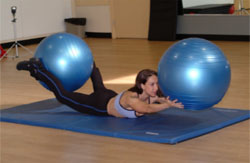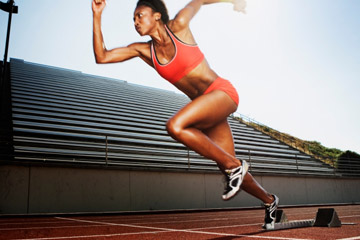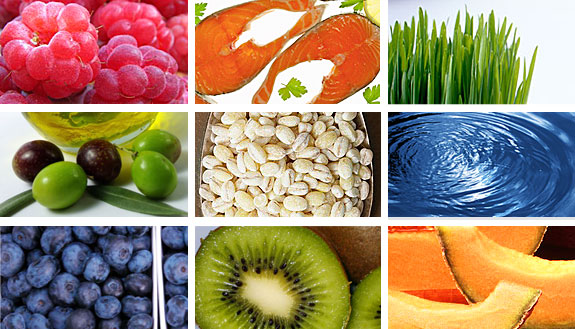Players that possess all of the tennis fitness components of strength, flexibility, speed and the proper nutrition will be best suited to win tennis matches.
Tennis fitness components are more than just running or exercising on a regular basis. For world class tennis players and any accomplished athlete, tennis fitness components involve highly specific aspects of a tennis training program. In the high performance tennis environment, players spend a large amount of time training the physical tennis fitness element of their game.
Most of these tennis fitness components are composed of highly specific exercises that are performed off the court in most cases. This is the time spent in the gym, working on elements such as flexibility, speed, agility, proper nutrition for tennis and a variety of other factors that relate to the fitness part of tennis.
We’ve already established that high performance tennis players undoubtedly include a host of different tennis fitness components inside their tennis training program. For club players, even they can benefit from undergoing some of these fitness routines to not only strengthen their physical prowess, but to provide them with a distinct advantage over their out of shape counterparts. This article will discuss some of the tennis fitness components needed to succeed at a high level of tennis.
Tennis Fitness Components At the Pro Level


The power that she generated was almost like the power of some of the men. But there was a big, literally big, problem. She was too… big. Like overweight big. This prevented her from moving well around the court. Also, she was very self-conscious which made it hard for those around her to point out this problem.
Despite all this, she got to the top 10. But if she was ever going to fulfil her destiny of becoming number one, she needed to get into better shape.
In 1998, after years of gradually shedding the pounds, she finally achieved her ideal weight and fitness level. As a result, she won her first grand slam title at the US Open and reached the number one ranking. She was able to maintain her fitness until she retired. Impressively, she was even able to come back to the tour after giving birth, though she has now since retired permanently.
Lindsay Davenport’s Realization on Tennis Fitness Components
Davenport realized during her journey to achieving fitness, that it was not enough for her to develop physical strength, flexibility and endurance. Although she tried her best to be as fast and agile as she could be, the extra weight she was carrying prevented her from reaching her full potential. So she had to change her diet. She didn’t want to completely give up the kind of food she liked to eat so she didn’t cut them out completely; she just greatly reduced the amount that she was consuming. In short, she had to pay attention to all of these tennis fitness components before she could do a fitness program that could really elevate her game.
As ordinary mortal players, we can learn a whole lot from what Davenport did. We may not be as talented as her but if we want to improve and take our game to the next level, we can do the same thing she did. We must pay attention to all the tennis fitness components and work on all of them.
Taking a Closer Look At Tennis Fitness Components
What exactly are these tennis fitness components? Let’s look at it by analysing what we see when we watch a tennis match. The first thing that you could notice is that the player who can hit with more power has an advantage. So it stands to reason that a stronger player is a better player. The first component is therefore strength. The second obvious thing to see is that a player who can run down more balls usually wins. Therefore, a faster player is also a better player; which brings us to the next component: speed. In relation to this, a player who can shift and change directions quickly is also at an advantage. He or she cannot easily be wrong-footed and sent off-balance. So another component is agility.
In a long match, one player usually gets tired before the other and loses because of this. So the fourth component would be stamina. Looking more closely, there are some players whose techniques are just not as good as others. There may be hitches in their motions and they look tight when running or stretching for a wide shot. If you examine the careers of these players, you might find that they have suffered injuries more frequently than others. This is related to their lack of flexibility, which would then be the fifth component. The last component is the thing that Lindsay Davenport worked very hard on in order to lose excess weight: diet.
Tennis Fitness Component #1: Core Strength


These parts are the elbow, wrist and shoulder (especially the rotator cuff).
Because tennis is a sport that makes use of some muscles more than others, strength training for tennis requires that all the different muscles of the body be developed in a more balanced way in order to prevent injuries and possible disabilities resulting from imbalanced development.
Core strength (abdominals and lower back), lower body strength (hips, legs and calves), upper body strength (shoulders, chest and upper back) and arm strength are all sub-components that need equal attention and work. As we have mentioned, greater strength contributes to greater power on all strokes. Now, you will be less likely to be overpowered on court.
Tennis Fitness Components #2: Speed, Agility and Stamina


Tennis is a sport that features bursts of vigorous activity followed by periods of rest. And these bursts of activity vary from match to match, set to set and even point to point. You might play a long rally on one point and then a short one on the next.
In either case, after each point, you have to recover, relax and get ready for the next point. So the kind of endurance you need to develop is the kind that will enable you to still run maximum bursts of speed even if you have already spent more than 2 hours out on the court. It makes better sense to create a program that develops a player’s speed, stamina and endurance all together.
Tennis Fitness Components: Footwork Drills
An example would be doing a series of sprints or lateral footwork drills in sets. To illustrate this further, you could run a 25 meter sprint, rest, and then do another sprint, until this whole process has been repeated 10 times.
You could do the same thing with lateral footwork drills, backpedalling footwork drills, shuttle runs and the like. Training for these three fitness components can really take your game up a notch. You can run down more balls for a longer time without getting as tired as you used to. Now you can outrun, outmanoeuvre and outlast opponents.
Tennis Fitness Components #3: Flexibility
The next tennis fitness component is flexibility. It is very important to warm up properly before working out or playing. Dynamic stretching is recommended for warming before an activity. This kind of stretching makes use of speed of movement and momentum to achieve the desired stretch. Examples are arm circles and lunges, as well as the movements used in many dance aerobics routines.
After activity, a player must cool down, and this is where static stretches are performed. These are stretches where the positions are held for a few counts. The proper use of these stretching techniques minimizes the chance of developing injuries. They also contribute to developing strokes that are more biomechanically sound. You will find that you are really now elevating your game.
Tennis Fitness Components #4: Tennis Diet and Proper Nutrition
The last tennis fitness component is diet and proper nutrition. Strength training is related to muscle building so a good amount of high quality protein should be included in the diet. Likewise, before a match, you never know if you will be out on court for half an hour or two and a half hours.


You need to be prepared for the contingency that you will be out there for a long time. A marathon runner or triathlete does what they call carbo loading, where they eat a good amount of complex carbohydrates before their race. This ensures that they have adequate and proper fuel.
A tennis player should also include similar kinds of carbohydrates before playing a match. During a match, a player should also have a few bites of energy bars during changeovers and bananas. These foods provide energy and electrolytes, which are lost when we sweat. Because every person is different, every diet should also be different and tailored to each one’s individual physiology.
As ordinary players, we do not need to follow strict diets because, after all, we should be allowed to enjoy our food. Lindsay Davenport didn’t totally eliminate sweets and pastries from her diet; she just greatly reduced the amount she was eating. She exercised portion control. We can learn from her example by just reducing the amount of sweets and treats we consume, but not totally deprive ourselves.
Getting into shape through proper nutrition and diet goes hand in hand with all the other components. As Davenport showed, you too can take your game to where it’s never been before by working on these tennis fitness components.
Learn to Hit a Forehand Like Roger Federer
If you want to jumpstart your forehand and play like the PROS, check out my 70+ page Tennis Ebook that will immediately show you how you can take your forehand to the next level.
The Modern Forehand Domination Ebook is guaranteed to improve your tennis technique, and increase power, topspin and accuracy of your tennis forehand!
Modern Tennis Forehand Ebook
Learn How to Hit a Forehand Like Federer, Nadal and Djokovic

